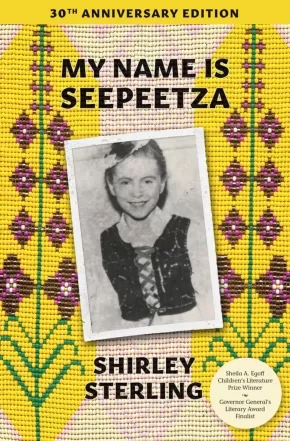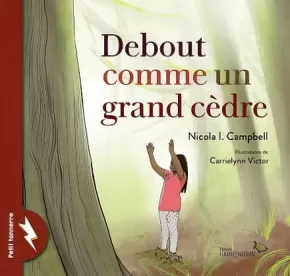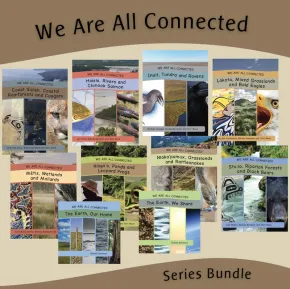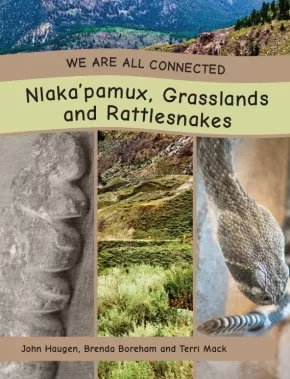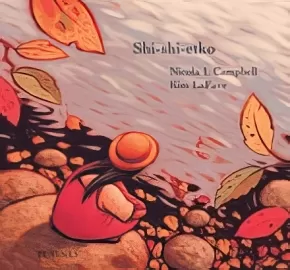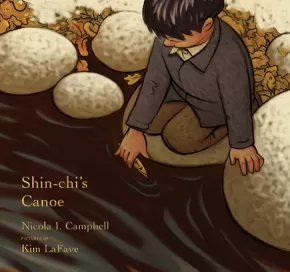
Nlaka'pamux (Thompson)
1
-
11
of
11 Results;
Sort By
Heartbeat of the Earth: A Handbook on Connecting Children to Nature through Indigenous Teachings
$47.75
Artists:
Format:
Paperback
Text Content Territories:
Indigenous Canadian;
ISBN / Barcode: 9781778258701
Synopsis:
Synopsis:
Nature is a place to both play and learn. The physical self is moving and active, the mental self is thinking and questioning, the emotional self is feeling and experiencing, and the spiritual self is connecting and thankful. We see what we have been taught to see. We love and respect our natural surroundings when we see ourselves as belonging to that community. This resource leads readers on a rich learning journey as they deepen their connections to nature and culture.
The activities inside instill traditional teachings of respect, honour, resourcefulness, and humility in children. This handbook is intended to inspire parents, caregivers, and educators to provide children with meaningful outdoor experiences interwoven with traditional indigenous knowledge.
Educator Information
For use with children.
Table of Contents
Introduction
The Power of Ceremony
- Introduction
- Ceremony and Daily Life
- Sunrise Ceremony
- Nature Picnic
- Sharing
- Navajo Forgiveness Ceremony
- Smudging Ceremony
Mindfulness: Meditation of Gratitude
- Introduction
- Gratitude
- Silent Study
- Sensory Wake-Up
- Walking Meditation
- Guided Meditation
- Nature Meditation
- Traditional Prayers
We Are All Related
- Honouring the Plants, Earth and Water
- Medicine Wheel Teachings in Nature
- Water is Life
- Find the Rock Game
- Adopt a Tree
- Read a Tree
- Earthing
- Build a Nature Structure
Swimmers, Walkers and Fliers
- The Animal People
- Walk Like the Animal People
- Tracking
Indigenous Games
- Introduction
- Blindfold Detective
- Stalk the Drum
- Fire Keeper
- Deer Cliff Arrow
- Hunter
- Run and Scream
- Metis Map-Making
Conclusion
Additional Information
84 pages | 9.00" x 7.00" | Paperback
My Name is Seepeetza: 30th Anniversary Edition
$12.99
Format:
Paperback
Text Content Territories:
Indigenous Canadian; First Nations; Salish; Interior Salish; Nlaka'pamux (Thompson);
ISBN / Barcode: 9781773068565
Synopsis:
Synopsis:
An honest look at life in an Indian residential school in the 1950s, and how one indomitable young spirit survived it — 30th anniversary edition.
Seepeetza loves living on Joyaska Ranch with her family. But when she is six years old, she is driven to the town of Kalamak, in the interior of British Columbia. Seepeetza will spend the next several years of her life at an Indian residential school. The nuns call her Martha and cut her hair. Worst of all, she is forbidden to “talk Indian,” even with her sisters and cousins.
Still, Seepeetza looks for bright spots — the cookie she receives at Halloween, the dance practices. Most of all, there are her memories of holidays back at the ranch — camping trips, horseback riding, picking berries and cleaning fish with her mother, aunt and grandmother. Always, thoughts of home make school life bearable.
Based on her own experiences at the Kamloops Indian Residential School, this powerful novel by Nlaka’pamux author Shirley Sterling is a moving account of one of the most blatant expressions of racism in the history of Canada.
Includes a new afterword by acclaimed Cree author Tomson Highway of the Barren Lands First Nation in northern Manitoba.
Educator Information
Recommended for ages 9 to 12.
Key Text Features: afterword, dialogue, journal entries, maps.
Correlates to the Common Core State Standards in English Language Arts:
CCSS.ELA-LITERACY.RL.4.2
Determine a theme of a story, drama, or poem from details in the text; summarize the text.
CCSS.ELA-LITERACY.RL.5.1
Quote accurately from a text when explaining what the text says explicitly and when drawing inferences from the text.
CCSS.ELA-LITERACY.RL.6.6
Explain how an author develops the point of view of the narrator or speaker in a text.
Includes a new afterword by acclaimed Cree author Tomson Highway of the Barren Lands First Nation in northern Manitoba.
Additional Information
128 pages | 5.10" x 7.50"
Debout comme un grand cedre
$19.95
Artists:
Format:
Hardcover
Text Content Territories:
Indigenous Canadian; First Nations; Salish; Coast Salish; Sto:lo; Interior Salish; Nlaka'pamux (Thompson);
ISBN / Barcode: 9782923926759
Synopsis:
Synopsis:
Quand vous faites une marche en nature, qui voyez-vous? Qu’entendez-vous?La conteuse Nicola I. Campbell donne sens aux mots « se tenir debout comme un grand cèdre » dans une touchante exploration au sein de la nature sauvage. On y apprend le nom des animaux en langues nle?kepmxcín et halq’emeylem ainsi que les enseignements qu’ils ont à nous offrir.Autrice de Shi-shi-etko et de La pirogue de Shin-chi, deux textes primés, Nicola I. Campbell nous offre ici un album pour enfants magnifiquement illustré par l’artiste Carrielynn Victor, dans une langue poétique qui nous invite à célébrer l’environnement, le développement durable et le sentiment d’appartenance à la terre.
Educator Information
Dès 6 ans
This book is available in English: Stand Like a Cedar
Additional Information
Hardcover
Stand Like a Cedar
$21.95
Artists:
Format:
Hardcover
Text Content Territories:
Indigenous Canadian; First Nations; Salish; Interior Salish; Nlaka'pamux (Thompson); Coast Salish; Sto:lo;
ISBN / Barcode: 9781553799214
Synopsis:
Synopsis:
When you go for a walk in nature, who do you see? What do you hear?
Award-winning storyteller Nicola I. Campbell shows what it means “to stand like a cedar” on this beautiful journey of discovery through the wilderness. Learn the names of animals in the Nłe7kepmxcín or Halq’emeylem languages as well as the teachings they have for us. Experience a celebration of sustainability and connection to the land through lyrical storytelling and Carrielynn Victor’s breathtaking art in this children’s illustrated book.
Discover new sights and sounds with every read.
Reviews
"Stand Like a Cedar is a work of grace and dignity, a celebration of land, family, and knowing who you are and where you come from and being so grateful for everything you’ve been given. Bravo, Nicola Campbell and Carrielynn Victor for creating this treasure. I love it."—Richard Van Camp, author of Little You and A Blanket of Butterflies
"Campbell’s rhythmic writing is wonderful, conveying important messages about the environment and family. Victor’s vibrant renderings accompany the engaging text nicely. Bold illustrations portray elements such as weather, nature, and animals alongside evocative details like glowing skylines. An Indigenous girl shares vivid lessons in this lovely, thoughtful environmental tale." —Kirkus Reviews
"Stand Like a Cedar is a story that connects the journey of building connections through a journey in the wilderness. Through the blended use of the Nłeʔkepmxcín and Halq'emeylem languages, readers are exposed to the healing that takes place in nature. The lyrical storytelling celebrates the healing and strength that comes from building one’s connections to their own journey." - The Dalai Lama Center
Educator Information
Recommended for ages 6 to 9.
Learn the names of animals in the Nłe7kepmxcín or Halq’emeylem languages as well as the teachings they have for us.
Includes a glossary of phrases and a translation guide.
Includes a page of back matter on Coastal and Interior Salish Languages.
This book is available in French: Debout comme un grand cedre
Additional Information
40 pages | 8.12" x 7.75"
La pirogue de Shin-chi
$12.95
Artists:
Format:
Paperback
Text Content Territories:
Indigenous Canadian;
ISBN / Barcode: 9782896118076
Synopsis:
Synopsis:
« Au bout du couloir, dans l’aile des petits garçons, Shin-chi était allongé dans son lit mais ne dormait pas. Il tenait précieusement sa petite pirogue dans la main. L’odeur parfumée du cèdre lui rappelait celle de son père. »Quand les Européens sont arrivés en Amérique, ils ont estimé que les Autochtones étaient des peuples non civilisés. Ils les ont chassés de leurs terres traditionnelles et les ont relégués dans des réserves. À la fin des années 1800, les gouvernements ont décidé de coloniser les enfants autochtones, de les forcer à s’adapter au mode de vie européen. Au Canada et aux États-Unis (mais également en Australie et en Nouvelle-Zélande), des lois furent adoptées obligeant les jeunes Autochtones à être éduqués dans des pensionnats autochtones.Dans ces établissements, les enfants apprenaient la culture, la religion et la langue des Européens. On leur donnait un nom européen. On leur enseignait le jardinage, l’agriculture et la menuiserie. On leur interdisait de parler à leurs parents ou à leurs frères et sœurs. Ils n’avaient pas non plus le droit de parler leur langue ni de pratiquer leurs coutumes. Certains enfants n’ont pu retourner chez eux qu’après de nombreuses années passées au pensionnat. D’autres n’y sont jamais retournés. Le Canada a compté environ 130 pensionnats indiens, et quelque 80 000 personnes vivant encore aujourd’hui y ont séjourné.
Educator Information
This book is available in English: Shin-chi's Canoe
A Day With Yayah
$21.95
Artists:
Format:
Hardcover
Text Content Territories:
Indigenous Canadian; First Nations; Salish; Interior Salish; Nlaka'pamux (Thompson);
ISBN / Barcode: 9781926890098
Synopsis:
Synopsis:
Set in the Okanagon, BC, a First Nations family goes on an outing to forage for herbs and mushrooms. Grandmother passes down her knowledge of plant life to her young grandchildren.
Reviews
"A Day With Yayah is a story sharing the special relationship that is built when a child learns from their Elders. It centers around an Indigenous family out on the land picking herbs and the Grandmother passing down her knowledge." - The Dalai Lama Center
Educator Information
Recommended for grades K-2 for the following subjects: Art Education, English Language Arts, Social Studies.
This resource offers a glimpse into the Nłeʔkepmx of the Nicola Valley in BC's Interior. A glossary of Nłeʔkepmxcin words appears at the back of the book.
Additional Information
32 pages | 9.25" x 10.25" | colour illustrations
We Are All Connected Series Bundle
 $179.55 $199.50
$179.55 $199.50

Text Content Territories:
Indigenous Canadian; First Nations; Salish; Coast Salish; Sto:lo; Interior Salish; Nlaka'pamux (Thompson); Nisga'a; Haisla (Kitamaat); Sioux; Lakota; Inuit; Métis;
ISBN / Barcode: 9781771745963
Synopsis:
Synopsis:
“We Are All Connected” is a series that explores how we all live together in a shared balance upon Mother Earth. Each book explores a specific ecosystem with a focus on one animal and its adaptations for survival within that ecosystem. Indigenous interviewees, each living within the same area, have responded to strategic questions as to how their community interacts with the land, their traditional territory. Explore each text with a sense of inquiry in mind.
8 We Are All Connected Titles Coast Salish, Coastal Rainforests and Cougars Haisla, Rivers and Chinook Salmon Inuit, Tundra and Ravens Lakota, Mixed Grasslands and Bald Eagles Métis, Wetlands and Mallards Nisga'a, Ponds and Leopard Frogs Nlaka'pamux, Grasslands and Rattlesnakes Sto:lo, Riparian Forests and Black Bears Each title covers the following curricular areas. Traditional storytelling and artwork begin each title from the focus Indigenous territory. Science: Biodiversity, classification, life cycles, food chains, food webs and connections between living and non-living things are just some of the science concepts included in each book. Social Studies: Contemporary and historical Indigenous cultural knowledge flows throughout each book. Local land forms, gatherings, harvesting practices and government are some of the social studies concepts included in each book.
2 Foundation Titles The two foundational books provide deeper understanding of the content of the “We Are All Connected” titles. We Are All Connected: The Earth, Our Home- explores biomes, ecosystems and biodiversity. We Are All Connected: The Earth, We Share- explores the interconnectedness between living and non-living things. View: We Are All Connected Learning Intentions
Additional Information
ISBN: 9781771745963
We Are All Connected: Nlaka'pamux, Dry Grasslands and Rattlesnakes
 $21.95
$21.95

Format:
Paperback
Text Content Territories:
Indigenous Canadian; First Nations; Salish; Interior Salish; Nlaka'pamux (Thompson);
ISBN / Barcode: 9781771742528
Synopsis:
Synopsis:
“We Are All Connected” is a series that explores how we all live together in a shared balance upon Mother Earth. Each book explores a specific ecosystem with a focus on one animal and its adaptations for survival within that ecosystem. Indigenous interviewees, each living within the same area, have responded to strategic questions as to how their community interacts with the land, their traditional territory. Explore each text with a sense of inquiry in mind.
8 We Are All Connected Titles Coast Salish, Coastal Rainforests and Cougars Haisla, Rivers and Chinook Salmon Inuit, Tundra and Ravens Lakota, Mixed Grasslands and Bald Eagles Métis, Wetlands and Mallards Nisga'a, Ponds and Leopard Frogs Nlaka'pamux, Grasslands and Rattlesnakes Sto:lo, Riparian Forests and Black Bears Each title covers the following curricular areas. Traditional storytelling and artwork begin each title from the focus Indigenous territory. Science: Biodiversity, classification, life cycles, food chains, food webs and connections between living and non-living things are just some of the science concepts included in each book. Social Studies: Contemporary and historical Indigenous cultural knowledge flows throughout each book. Local land forms, gatherings, harvesting practices and government are some of the social studies concepts included in each book.
2 Foundation Titles The two foundational books provide deeper understanding of the content of the “We Are All Connected” titles. We Are All Connected: The Earth, Our Home- explores biomes, ecosystems and biodiversity. We Are All Connected: The Earth, We Share- explores the interconnectedness between living and non-living things.
Authenticity Note: This title includes some authentic Indigenous photographs.
Additional Information
32 pages | 8.50" x 11.00" | ISBN: 9781771742528
Grandpa's Girls
$18.99
Artists:
Format:
Hardcover
Text Content Territories:
Indigenous Canadian; First Nations; Salish; Interior Salish; Nlaka'pamux (Thompson);
ISBN / Barcode: 9781554980840
Synopsis:
Synopsis:
A young girl delights in a visit to her grandpa's farm. She and her cousins run through the fields, explore the root cellar where the salmon and jars of fruit are stored, swing on a rope out the barn loft window, visit the Appaloosa in the corral and tease the neighbor's pig. The visit is also an opportunity for this child to ask Grandpa what her grandmother, Yayah, was like, and to explore the "secret room," with its old wooden trunk of ribbons, medals and photos of Grandpa in uniform.
There is a wonderful blend of fun and family history in this visit to a grandparent, and the realization that there can be some things about the people we know and love that will always remain a mystery. But above all, there's nothing like being with Grandpa.
In her two previous picture books, Shi-shi-etko and Shin-chi's Canoe, Nicola Campbell worked with elders and survivors of residential schools, documenting the tragic experiences that many endured. This new book, based on her own childhood memories, is a sunny, joyful story, vibrantly illustrated by Kim LaFave.
Reviews
"Grandpa’s Girls follows a group of four cheerful Interior Salish cousins let loose on their grandfather’s sprawling B.C. farm.... The book is a vicarious pleasure for anyone who ever wished they’d once had a hay loft to swing from, a pig to tease, or a cobwebby root cellar to explore. Beyond that, it is an honest look at how kids sometimes need to experience the past in the context of the present to really understand it." - Quill & Quire
Educator Information
Curriculum Connections: Social Studies, Visual Arts, History
Recommended Ages: 4 - 7
Additional Information
32 pages | 7.50" x 9.63"
Shi-shi-etko
$19.99
Artists:
Format:
Hardcover
Text Content Territories:
Indigenous Canadian;
ISBN / Barcode: 9780888996596
Synopsis:
Synopsis:
In just four days young Shi-shi-etko will have to leave her family and all that she knows to attend residential school.
She spends her last days at home treasuring the beauty of her world -- the dancing sunlight, the tall grass, each shiny rock, the tadpoles in the creek, her grandfather's paddle song. Her mother, father and grandmother, each in turn, share valuable teachings that they want her to remember. And so Shi-shi-etko carefully gathers her memories for safekeeping.
Richly hued illustrations complement this gently moving and poetic account of a child who finds solace all around her, even though she is on the verge of great loss -- a loss that native people have endured for generations because of the residential schools system.
This gentle story of a child on the verge of great loss was selected as the Aboriginal Children’s Book of the Year.
Awards
- Winner of the Anskohk Aboriginal Children's Book of the Year Award.
Educator Information
Recommended Grades: 1-10.
Curriculum Connections: Indigenous Studies, Visual Arts, Science, Health.
Recommended Authentic First Peoples resource K-9.
This illustrated children's story is recommended for English First Peoples Grades 10 for units pertaining to childhood through Indigenous writers' eyes and the exploration of residential schools and reconciliation through children's literature.
This book is available in French: Shi-shi-etko (French)
Additional Information
32 pages | 8.50" x 8.13"
Shin-chi's Canoe
$18.95
Artists:
Format:
Hardcover
Text Content Territories:
Indigenous Canadian;
ISBN / Barcode: 9780888998576
Synopsis:
Synopsis:
This moving sequel to the award-winning Shi-shi-etko tells the story of two children's experience at residential school. Shi-shi-etko is about to return for her second year, but this time her six-year-old brother, Shin-chi, is going, too. As they begin their journey in the back of a cattle truck, Shi-shi-etko takes it upon herself to tell her little brother all the things he must remember: the trees, the mountains, the rivers and the tug of the salmon when he and his dad pull in the fishing nets. Shin-chi knows he won't see his family again until the sockeye salmon return in the summertime.
When they arrive at school, Shi-shi-etko gives him a tiny cedar canoe, a gift from their father. The children's time is filled with going to mass, school for half the day, and work the other half. The girls cook, clean and sew, while the boys work in the fields, in the woodshop and at the forge. Shin-chi is forever hungry and lonely, but, finally, the salmon swim up the river and the children return home for a joyful family reunion.
Awards
- 2009 TD Canadian Children’s Literature Award
- 2008 Governor General’s Literary Award for illustration
Reviews
"Shin-Chi’s Canoe is a story about a brother and sister sent to a residential school and the separation from their culture they experience. Shin-Chi finds comfort with a little cedar canoe and the dream of returning home like the salmon. The children both find peace and strength by connecting to Mother Earth and the water. The story acknowledges the residential school system's devastating events while highlighting Indigenous children's strength and resiliency." - The Dalai Lama Center
Educator Information
Recommended Grades: 2-10.
Recommended Authentic First Peoples K-9 resource.
This illustrated children's story is recommended for English First Peoples Grades 10 for units pertaining to childhood through Indigenous writers' eyes and the exploration of residential schools and reconciliation through children's literature.
This book is available in French: La pirogue de Shin-chi
Additional Information
40 pages | 8.50" x 8.13"
Sort By




